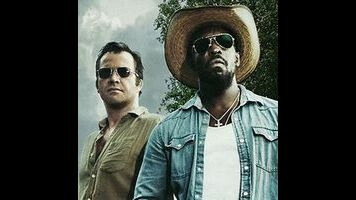Texan pulp author Joe R. Lansdale writes the type of colorful crime stories that would seem to lend themselves perfectly to screen adaptations. That’s especially the case for Lansdale’s Hap And Leonard novel series, the kind of culturally specific Elmore Leonard-riff with messy characters who fit neatly into a three-act structure. But much like Leonard’s work, Lansdale’s stories and characters are easy enough to port to film and television, but the ambiguous, darkly comic tone is a wide target with a very narrow bullseye. For every Justified—the show SundanceTV’s Hap And Leonard most resembles—there’s a Be Cool to symbolize the margin for error.
The season’s plot, which pulls from several of Lansdale’s novels, is a soundly constructed caper tale, with Hap and Leonard getting roped into a job after a tip from Trudy. The scheme is simple enough: Locate a small, unmarked bridge, dive into the river to retrieve a sunken treasure, then split the money and live the easy life. It’s an attractive plan to Hap and Leonard because they’ve been fired from their farm labor jobs, and they have complementary skill sets for the task at hand. Hap knows the area as intimately as Trudy’s silhouette, and Leonard, a former Marine, has the diving skills to navigate the murky river. Of course, the genre demands that the best-laid plans go awry, and this one takes a weird left early on, when Hap and Leonard are introduced to the score’s architect, Trudy’s new hippy boyfriend Howard (Bill Sage), and his ragtag gang.
For all Hap And Leonard’s strengths, it pitches a bit wide of the plate in terms of its tone. The show struggles to find a comfortable balance of its many genre elements, not to mention its 1980s Texas setting, and even at the story’s high points, it can feel like the actors are outperforming their material. That’s as much to do with the source material as with the way it’s been adapted. Lansdale revels in creating surreal universes in his novels, but on the page it’s far easier to balance the dramatic elements—like the tragic origin story of Hap and Leonard’s unlikely friendship—with sillier elements like Howard’s oddball partners in crime.
There are also the moments of gruesome violence, which most often come at the hands of the show’s Big Bad Soldier (Jimmi Simpson) and his sadistic girlfriend Angel (Pollyanna McIntosh), who evokes a direct descendant of Jeramie Rain’s feral character in the original Last House On The Left. In the three episodes screened for critics, the couple is a looming threat slowly closing in on the heroes, but there’s more to the sense that Soldier and Angel feel like part of a different show than the fact that they’re physically separate in the early episodes. The bloody murder is endemic to Lansdale’s style, so the scenes aren’t gratuitous, but they are a bit excessive. That complaint appears to miss the point, but there’s a good reason Quentin Tarantino opted to animate the Japanese revenge tale in Kill Bill: Volume One. The key to nailing these kinds of stories is knowing when to pull back, and Damici and Mickle don’t always relent when they should.
Fortunately, the actors are just as relentless. Purefoy remains best-known Stateside for his role as the leader of a murder cult in the brain-dead The Following, and while Hap And Leonard is too narrowly appealing to reach a wide audience, a select few will see how rakishly appealing Purefoy can be in the right role. Williams isn’t quite as compelling as this gay tough guy role as he was in The Wire, partly because Williams’ Southern accent is a patchwork of at least a half-dozen black dialects. (The dodgy elocution amplifies the fuzzy sense of place, a result of Louisiana locations acting as east Texas locales.) But he more than holds his own, and he makes the most of the dialogue, which is occasionally over-stylized, leaving Williams to animate a few folksy bon mots that would sink if not for his hard work.
The best thing going for Hap And Leonard is its length. That might sound like a slight, but it’s actually a compliment. There’s the distinct feeling that whatever weaknesses crop up in the first three episodes of Hap And Leonard might resolve themselves in the second half, because it’s so evidently conceived and executed like a six-hour movie. Between the bright performances and the mischievous genre-bending, it’s certainly worth a cheap fling.

